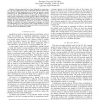Free Online Productivity Tools
i2Speak
i2Symbol
i2OCR
iTex2Img
iWeb2Print
iWeb2Shot
i2Type
iPdf2Split
iPdf2Merge
i2Bopomofo
i2Arabic
i2Style
i2Image
i2PDF
iLatex2Rtf
Sci2ools
INFOCOM
2009
IEEE
2009
IEEE
Barrier Information Coverage with Wireless Sensors
Abstract—Sensor networks have been deployed for many barrier coverage applications such as intrusion detection and border surveillance. In these applications, it is critical to operate a sensor network in an energy-efficient manner so the barrier can be covered with as few active sensors as possible. In this paper, we study barrier information coverage which exploits collaborations and information fusion between neighboring sensors to reduce the number of active sensors needed to cover a barrier and hence to prolong the network lifetime. Moreover, we propose a practical solution to identify the barrier information coverage set which can information-cover the barrier with a small number of active sensors. The effectiveness of the proposed solution is demonstrated by numerical and simulation results.
Active Sensors | Barrier Coverage Applications | Barrier Information Coverage | Communications | INFOCOM 2009 |
| Added | 24 May 2010 |
| Updated | 24 May 2010 |
| Type | Conference |
| Year | 2009 |
| Where | INFOCOM |
| Authors | Guanqun Yang, Daji Qiao |
Comments (0)

